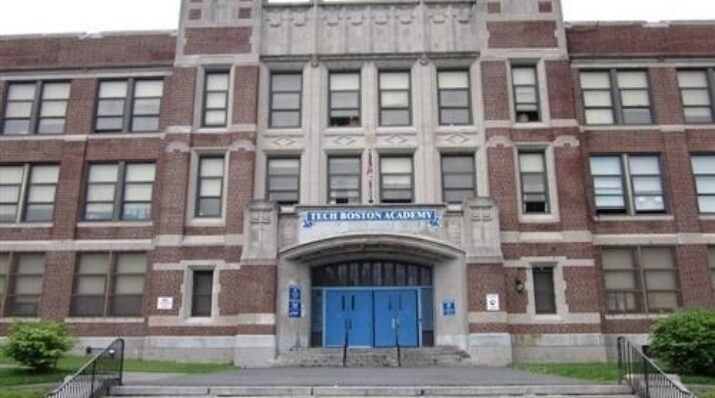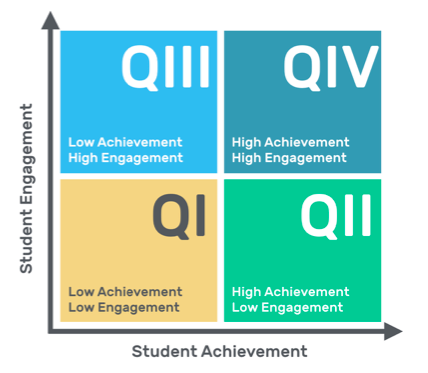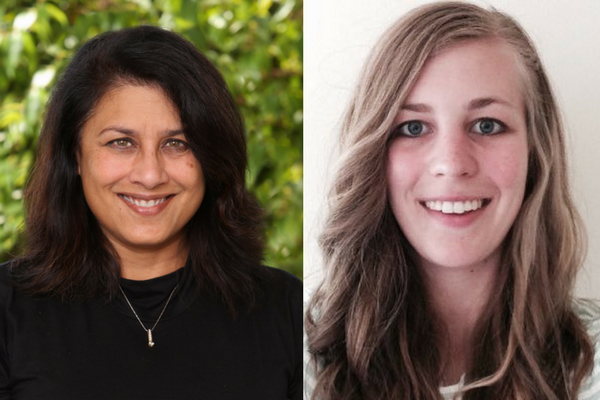New Designs for School
An Innovation Conversation in the Nation's Oldest School District
Topics

We’ve all had the experience of truly purposeful, authentic learning and know how valuable it is. Educators are taking the best of what we know about learning, student support, effective instruction, and interpersonal skill-building to completely reimagine schools so that students experience that kind of purposeful learning all day, every day.
Two educators in Boston Public Schools discuss the challenges of—and possible solutions for—making the transition to an innovative school model.
The Context
The Boston Public Schools (BPS) under the leadership of Superintendent Tommy Chang has made innovation one of the district's three core values (the others being equity and coherence). Innovation, to us at BPS, means building a culture of change: an organization that generates new solutions rather than simply continuing along established paths; an organization that provides equitable opportunities for its students to learn in a rapidly changing world; an organization that launches the leaders, scholars, entrepreneurs, advocates, and innovators of tomorrow.
TechBoston Academy, an open enrollment 6-12 school in Boston's urban core, is one of BPS's leaders in this work. I asked their Director of Innovation, Jennifer Nicol, about some of the challenges they face as they innovate.
The Lived Problem of Practice
—Jennifer Nicol
I make a habit of reading articles and watching videos that highlight different schools around the country. In the videos, there are always happy, engaged students who are climbing a mountain, to build a windmill, that will fuel a new animal shelter the class before them built from recycled materials. As I watch these videos, I think, "TechBoston Academy has great students! We have great teachers! We could climb a mountain, to build a windmill, to fuel the animal shelter!"
Of course it's not really the mountain, windmill, or animal shelter that motivates me. It's the knowledge that students can authentically engage in their learning. They can have ownership and choice over legitimate real-world applications. At TechBoston, we are motivated by the belief that we can coach students as they develop into passionate, critically-thinking change-makers.
My conviction fades as I remember all of the traditional aspects of our 1,000-student school. The teacher who is trying his best to be innovative must pretend the state test is not looming in his students' future. He must pretend his students do not spend much of their day in traditional classrooms. Arguably most importantly, he must pretend that innovation isn't significantly more work when done within the confines of the traditional school. He must innovate within the restrictions of Carnegie unit-based credits, hour-long class schedules, and traditional course topics. He must find time outside of the scheduled professional development and professional learning communities to collaborate with colleagues on innovative practices. He must spend energy pretending the traditional elephant isn't standing here in his bow tie mocking us.
Even in my role as Director of Innovation, I find myself in an unsettling trap of only feeling justified researching, ideating, or piloting when my traditional tasks are completed. This belief that innovation is our dessert—the reward we only get to after we've eaten our vegetables—leaves educators in a position where they must add more onto their very full plates to innovate. I'm left wondering, will efforts to empower educators to design their own innovative practices fall short as long as they are restricted by traditional school structures?
At TechBoston Academy, we have meaningful pockets of innovation that aim to create learner-centered student-empowering experiences. To name a few, we have Teach to One: Middle School Math, flipped Algebra I classes, competency assessments in digital art, a student-led Civics in Action course, and 4th term seniors halt classes to pursue self-designed projects. Next year, we're adding advisory, five school-wide competencies to measure social-emotional and academic skills, a vibrant interactive learning commons, and an interdisciplinary project-based learning experience in the 9th grade. Our step toward student-centered innovation is evident. However, our schedule, courses, and teaching assignments remain traditional. Our students must still perform on standardized tests, meet traditional graduation requirements, and participate in the state-established seat time for course credit.
As a leader, this leaves me feeling stuck. How do I best support student-centered innovation? Do I continue to work to empower individuals and small teams of educators to innovate in hopes that eventually this will grow schoolwide? Or do I spend time rallying others to help me throw out the traditional structures?
For the 2017-2018 school year, TechBoston Academy is doing a little of both. We will begin a few innovative schoolwide practices such as advisory, five school-wide competencies to measure social-emotional and academic skills, and open a vibrant interactive learning common. We will have time devoted in professional development and critical friends groups to each of these new practices. Simultaneously, we will devote time, resources, and administrative support to teams and individuals excited to push the boundaries even further. We aim to shift our core culture while also supporting our innovative outliers. The hope is that we can all take steps together towards innovation. I continue to wonder though if at some point a majority will simply have to agree to leap, structural changes and all, recognizing that innovation is now a vegetable.
A Possible Reframing
—Sujata Bhatt
Thank you for framing your innovation dilemma so openly and honestly, Jen. First and foremost, let's acknowledge the complexity of the work you and the Tech Boston Academy (TBA) team are undertaking. While startup schools are very thought- and labor-intensive, transforming an existing organization is arguably the more difficult endeavor because you don't have the opportunity to grow culture from the ground up. As with the students who enter your classroom, you start where you and the TBA staff are, strengths, passions, traumas, conflicts, habits and all. And where you are is with a team with too full plates, a traditional structure, and a sense that innovation is dessert.
As I reread your post, I hear three different questions emerging:
- How do I, as a member of my school community, help redefine attitudes toward innovation (from occasional mouth-watering dessert to daily, nutritionally rich vegetables)?
- How do I, as a leader in my school's transformation work, decide how to prioritize?
- How do I, as a member of an institution shaped by regulations and traditions, enable our team to redesign the established ways of doing things that seem fixed (schedules, seat time, credit units, etc.)?
Dessert to Vegetables (or Main Course)
We adopt new things because they solve a problem in or add value to our lives. For the TBA community to shift from traditional teaching practices to a more student-centered approach, they need to define the problem they need solving, and explore the shift as a possible solution, and see if it adds value to what they do—which is help students learn—along a broad spectrum: for the state tests, for the next year's sequence of courses, for college and early career, for the innovation economy.

I wonder if there has been an exploration of a problem of practice regarding how students currently learn at the school and the spectrum along which that learning extends.
- Is the current approach working and how far along the spectrum does it reach?
- Has there been an effort to explore student perspectives on their educational goals and experiences, perhaps via surveys or empathy interviews?
- Have parents been brought into the conversation?
- Have faculty had a chance to go back to their 'why' for becoming teachers?
- Have they had (and taken) the opportunity to explore how the world and economy are shifting through the spread of new technologies that change how we live and work?
- Your voice is already in my head asking, "Great! But where, in the traditional structures of school, can we create the time and space to enable all this questioning?
Like medium and large high schools across the country, TBA has a staff of over 100, approximately 80 of whom are teachers. As your schedule currently stands, it would be almost impossible to find the time for the whole staff. But is there room to bring a few to this table?
Pathways to Change
If you start bringing a few people to the table, consider the innovators, those risk-taking 2.5% of your staff who are actively involved in your innovation pilots. According to Everett Rogers, a communications and sociology professor who wrote a now classic treatise, Diffusion of Innovations, these innovators need very little. Perhaps a little support on framing the problem of practice. Perhaps a little release time to shadow a student. Perhaps some encouragement to experiment with a new way of doing things. Perhaps a general framework for determining whether a project/lesson/activity/intervention/experiment was a success or failure (accompanied by a clear understanding that failure is not the end of the world). At this early stage of TBA's move to explore learning that puts students at the center of the learning process, the framework could be as simple as a quadrant chart (below) that looks at both student achievement and student engagement.

- Can time be created for your pockets of innovation to have conversations across their work using the quadrant chart above?
- Can plusses and deltas of the different innovative practices be mapped?
- Can new iterations or prototypes or experiments be launched?
- How can wins be celebrated and amplified?
As with student-centered learning, so with professional growth: the person doing the work is doing the learning. Once you begin to have a core group of people that feels safe enough to share what it is doing, you have an empowered learning community. You begin to create a social network that gives innovation credibility and respect and increasing safety which expands its reach beyond that core group.
Changing Established Ways of Doing Things
The big question! But once you have innovators and a few others on board, answering it becomes a collective responsibility.
- How real are those limitations?
- Are they in the ed code?
- Are they in district policy?
- Are there examples of other schools that have done things differently?
- How can we connect with them?
This is a research project made for teachers. Gather a design team or exploration team or tiger team to go after the answers: to find resources, experts, exemplars, etc. that can lead to different solutions. We spend our lives designing things (curriculum, assessments, classroom management systems, discipline policies, workarounds). Wouldn't it be so much more fun to design learning environments? And wouldn't the students enjoy joining the process?
Innovation is the act of creating, a joyous process as long as it isn't governed by musts (you must eat your vegetables). We no longer live in a world where vegetables are boiled or canned and not very appetizing; our vegetable possibilities are delicious and endless. Innovation can be, too.




